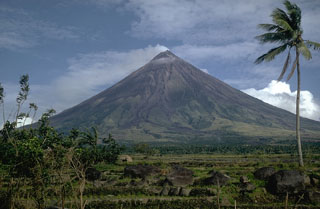Report on Mayon (Philippines) — 2 August-8 August 2006
Smithsonian Institution / US Geological Survey
Weekly Volcanic Activity Report, 2 August-8 August 2006
Managing Editor: Sally Sennert.
Please cite this report as:
Global Volcanism Program, 2006. Report on Mayon (Philippines) (Sennert, S, ed.). Weekly Volcanic Activity Report, 2 August-8 August 2006. Smithsonian Institution and US Geological Survey.
Mayon
Philippines
13.257°N, 123.685°E; summit elev. 2462 m
All times are local (unless otherwise noted)
PHIVOLCS reported that during 2-8 August, lava from Mayon continued to flow mainly SSE along the Mabinit channel and subsequently over a broad sector of the upper and middle SE slopes. During 17 July-3 August, the volume of lava discharged amounted to 17 million cubic meters. Voluminous steaming accompanied lava extrusion. On 4 August, lava flows extended 30 m beyond the 6-km-radius region designated as the Permanent Danger Zone. Areas SE and E experienced light ash fall on 4 August generated by the collapse of deposits. On 6 August, lava flows spilled into the Bonga Valley, E of the Mabinit Chanel.
The Tokyo VAAC reported an eruption cloud at 2331 that reached an altitude of 3.4 km (11,000 ft) a.s.l. and drifted E. On 7 August, the Alert Level was raised to 4 (scale is 0-5, 0 referring to No Alert status) and the Extended Danger Zone (8 km from the summit) was defined. Three explosions (out of nine in a 24-hour period) at 2236, 2246, and 2249 produced incandescent ejections of lava fragments, ash, gas, and steam. According to news reports, ~40,000 people were evacuated from inside the Extended Danger Zone to 20 evacuation centers on 7 and 8 August.
Geological Summary. Symmetrical Mayon, which rises above the Albay Gulf NW of Legazpi City, is the most active volcano of the Philippines. The steep upper slopes are capped by a small summit crater. Recorded eruptions since 1616 CE range from Strombolian to basaltic Plinian, with cyclical activity beginning with basaltic eruptions, followed by longer periods of andesitic lava flows. Eruptions occur predominately from the central conduit and have also produced lava flows that travel far down the flanks. Pyroclastic density currents and mudflows have commonly swept down many of the approximately 40 ravines that radiate from the summit and have often damaged populated lowland areas. A violent eruption in 1814 killed more than 1,200 people and devastated several towns.
Sources: Associated Press, Philippine Institute of Volcanology and Seismology (PHIVOLCS), Tokyo Volcanic Ash Advisory Center (VAAC)

